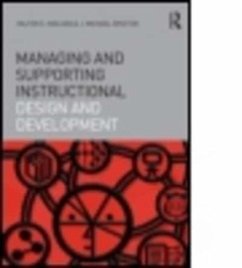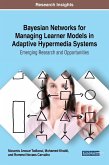Versandkostenfrei innerhalb Deutschlands
102,99 €
inkl. MwSt.
Versandkostenfrei*
Erscheint vorauss. 31. Dezember 2027
Melden Sie sich
hier
hier
für den Produktalarm an, um über die Verfügbarkeit des Produkts informiert zu werden.

51 °P sammeln
- Gebundenes Buch
Managing and Supporting Instructional Design and Development is a practical guide to managing multiple levels of instructional design activities, based upon management concept and application as well as instructional design process and application.
Andere Kunden interessierten sich auch für
![Supporting Early Mathematical Development Supporting Early Mathematical Development]() Caroline McgrathSupporting Early Mathematical Development152,99 €
Caroline McgrathSupporting Early Mathematical Development152,99 €![Managing the Transition from Print to Electronic Journals and Resources Managing the Transition from Print to Electronic Journals and Resources]() Managing the Transition from Print to Electronic Journals and Resources186,99 €
Managing the Transition from Print to Electronic Journals and Resources186,99 €![Managing Diverse Classrooms Managing Diverse Classrooms]() Carrie Rothstein-FischManaging Diverse Classrooms32,99 €
Carrie Rothstein-FischManaging Diverse Classrooms32,99 €![Managing Noncompliance and Defiance in the Classroom Managing Noncompliance and Defiance in the Classroom]() Geoff ColvinManaging Noncompliance and Defiance in the Classroom30,99 €
Geoff ColvinManaging Noncompliance and Defiance in the Classroom30,99 €![Managing Effective Teaching of Mathematics 3-8 Managing Effective Teaching of Mathematics 3-8]() Suzanne EdwardsManaging Effective Teaching of Mathematics 3-868,99 €
Suzanne EdwardsManaging Effective Teaching of Mathematics 3-868,99 €![Managing 21st Century Classrooms Managing 21st Century Classrooms]() Jane BluesteinManaging 21st Century Classrooms15,99 €
Jane BluesteinManaging 21st Century Classrooms15,99 €![Bayesian Networks for Managing Learner Models in Adaptive Hypermedia Systems Bayesian Networks for Managing Learner Models in Adaptive Hypermedia Systems]() Mouenis Anouar TadlaouiBayesian Networks for Managing Learner Models in Adaptive Hypermedia Systems147,99 €
Mouenis Anouar TadlaouiBayesian Networks for Managing Learner Models in Adaptive Hypermedia Systems147,99 €-
-
-
Managing and Supporting Instructional Design and Development is a practical guide to managing multiple levels of instructional design activities, based upon management concept and application as well as instructional design process and application.
Produktdetails
- Produktdetails
- Verlag: Taylor & Francis Ltd
- Seitenzahl: 224
- Erscheinungstermin: 31. Dezember 2027
- Englisch
- Abmessung: 254mm x 178mm
- ISBN-13: 9781138794535
- ISBN-10: 1138794538
- Artikelnr.: 42741088
- Herstellerkennzeichnung
- Libri GmbH
- Europaallee 1
- 36244 Bad Hersfeld
- gpsr@libri.de
- Verlag: Taylor & Francis Ltd
- Seitenzahl: 224
- Erscheinungstermin: 31. Dezember 2027
- Englisch
- Abmessung: 254mm x 178mm
- ISBN-13: 9781138794535
- ISBN-10: 1138794538
- Artikelnr.: 42741088
- Herstellerkennzeichnung
- Libri GmbH
- Europaallee 1
- 36244 Bad Hersfeld
- gpsr@libri.de
Milton C. Nielsen is Associate Vice President of Instructional Technologies Support at Texas State University. J. Michael Spector is Chair of Learning Technologies in the College of Information at the North Texas State University and is the editor of the Development Section of Educational Technology Research & Development.
Table of Contents
1. Introduction
* Basic Premise: ID & PM are Parallel, Dynamic, Interacting,
Complementary Processes
* How to Use the Book: Sequentially or Interleaving Special Topics
(Chapters 8 - 10) with Basic Topics (Chapters 2 - 5); Chapter 6 and 7
could be introduced with Basic Topics or with Application
Environments
1. A Single Lesson or Unit of Instruction
2. A Lesson Block or Major Topic Area
3. An Entire Course
4. A Program, Group of Courses, Certificate or Degree
5. Integration of Disciplines
6. Integration of Work Areas
7. Program and Project Evaluation
8. Special Topics
* Scope
* Estimation
* Funding
* Personnel
* Communication
* Resource Planning: Time, Personnel, Hardware/Software...
* Project Analysis
* Pilots and Prototypes
1. Instructional Technology Center
* Advisory Committees
1. Application Environments
* Online Courses
Labs (Virtual Labs, Augmented Labs, Interactive Simulations, etc.)
1. Introduction
* Basic Premise: ID & PM are Parallel, Dynamic, Interacting,
Complementary Processes
* How to Use the Book: Sequentially or Interleaving Special Topics
(Chapters 8 - 10) with Basic Topics (Chapters 2 - 5); Chapter 6 and 7
could be introduced with Basic Topics or with Application
Environments
1. A Single Lesson or Unit of Instruction
2. A Lesson Block or Major Topic Area
3. An Entire Course
4. A Program, Group of Courses, Certificate or Degree
5. Integration of Disciplines
6. Integration of Work Areas
7. Program and Project Evaluation
8. Special Topics
* Scope
* Estimation
* Funding
* Personnel
* Communication
* Resource Planning: Time, Personnel, Hardware/Software...
* Project Analysis
* Pilots and Prototypes
1. Instructional Technology Center
* Advisory Committees
1. Application Environments
* Online Courses
Labs (Virtual Labs, Augmented Labs, Interactive Simulations, etc.)
Table of Contents
1. Introduction
* Basic Premise: ID & PM are Parallel, Dynamic, Interacting,
Complementary Processes
* How to Use the Book: Sequentially or Interleaving Special Topics
(Chapters 8 - 10) with Basic Topics (Chapters 2 - 5); Chapter 6 and 7
could be introduced with Basic Topics or with Application
Environments
1. A Single Lesson or Unit of Instruction
2. A Lesson Block or Major Topic Area
3. An Entire Course
4. A Program, Group of Courses, Certificate or Degree
5. Integration of Disciplines
6. Integration of Work Areas
7. Program and Project Evaluation
8. Special Topics
* Scope
* Estimation
* Funding
* Personnel
* Communication
* Resource Planning: Time, Personnel, Hardware/Software...
* Project Analysis
* Pilots and Prototypes
1. Instructional Technology Center
* Advisory Committees
1. Application Environments
* Online Courses
Labs (Virtual Labs, Augmented Labs, Interactive Simulations, etc.)
1. Introduction
* Basic Premise: ID & PM are Parallel, Dynamic, Interacting,
Complementary Processes
* How to Use the Book: Sequentially or Interleaving Special Topics
(Chapters 8 - 10) with Basic Topics (Chapters 2 - 5); Chapter 6 and 7
could be introduced with Basic Topics or with Application
Environments
1. A Single Lesson or Unit of Instruction
2. A Lesson Block or Major Topic Area
3. An Entire Course
4. A Program, Group of Courses, Certificate or Degree
5. Integration of Disciplines
6. Integration of Work Areas
7. Program and Project Evaluation
8. Special Topics
* Scope
* Estimation
* Funding
* Personnel
* Communication
* Resource Planning: Time, Personnel, Hardware/Software...
* Project Analysis
* Pilots and Prototypes
1. Instructional Technology Center
* Advisory Committees
1. Application Environments
* Online Courses
Labs (Virtual Labs, Augmented Labs, Interactive Simulations, etc.)







